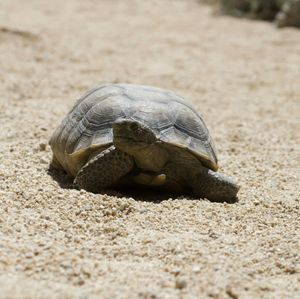
Dystocia, also known as “egg-binding”, includes pre- and post-ovulatory stasis or obstructive dystocia. Pre-ovulatory stasis is when the ovarian follicles fail to ovulate leaving mature follicles within the ovaries. Post-ovulatory stasis is true egg binding with the eggs left trapped in the oviducts. Underlying causes include poor husbandry, lack of appropriate nesting sites (substrate, depth, moisture, temperature), poor physical condition, nutritional secondary hyperparathyroidism (“metabolic bone disease”), malnutrition, other dietary imbalances, other endocrinopathies. It may also occur secondary to obstruction of the oviduct with bladder stones, tumors, or anatomic abnormalities. Egg yolk coelomitis can be a sequela to this condition.
Normal gravid chelonians may show anorexia, increased activity (especially nesting or pacing), and coelom with palpable eggs. Signs specific to dystocia are straining, difficulty passing feces, cloacal swelling or prolapse, depressed mentation, lethargy, hind leg weakness, or respiratory distress.
Conditions that may mimic this include coelomic tumors, bladder stones, abscess, or fecal masses/constipation.
Radiographs and/or ultrasound can be used to distinguish between normal and retained eggs. Retained eggs may have abnormal size, shape, or shell thickness, or be in the bladder. A complete blood count can be used to determine the current status of the immune system and check for any issues with anemia. A blood chemistry panel will help identify underlying metabolic illnesses and help evaluate for hypocalcemia.
Treatment for otherwise healthy animals mostly involves providing proper environmental conditions and nesting site for species. Sick or unstable animals should receive fluid and heat support. Lubrication of the cloaca may expedite removal of eggs visible within the cloaca and allow for manual removal. An injection of calcium should be given prior to oxytocin therapy. Sedation and pain control may also help the patient relax enough to pass the eggs more easily. If medical intervention is not successful or the egg cannot safely pass through the cloacal, surgical removal is indicated.
The prognosis is fair to good with treatment and supportive care, depending on the etiology of the dystocia. Dystocia can recur if the chelonian is not spayed.
Without surgery, follow up daily to monitor nesting behavior, mentation, and activity levels. With surgery, recommend recheck examination and suture removal in 4 weeks or sooner if not improving or worsening.
Copyright © All Rights Reserved
